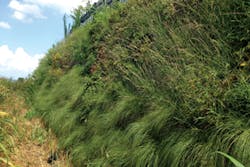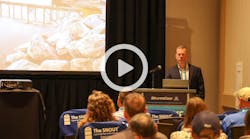The Indiana Central Canal was built between 1836 and 1839 by the same people who constructed the Erie Canal. The original intent of the canal was to connect the Wabash and Erie Canal to the Ohio River, but financial difficulties stopped the project short of the intended goal.
Today, the canal serves as a part of the Indianapolis water supply. It starts at Broad Ripple south of 64th Street and move water from the White River about 6.5 miles to the Citizens Energy White River Treatment Plant off 16th Street just west of downtown.
The downtown section of the canal from 11th Street to the White River, owned by the City of Indianapolis, is not part of the water distribution system.
Citizens Energy Group is a utility providing natural gas, thermal energy, water, and wastewater services to about 800,000 people and thousands of businesses in the Indianapolis area.
The part of the canal owned by Citizens Energy Group has 2:1 slopes and requires maintenance. The slopes consist primarily of turfgrass and some riprap.
To maintain it, “they have to mow it and weed-whack it,” notes J. Eric Spangler of Hoosier Aquatic Management. About three years ago, the utility sought a better way to maintain it, he says.
“They put out proposals to find out different techniques or methods that could be used on the side slopes so they could reduce the amount of maintenance,” says Spangler. “We proposed using the vegetated Living Log over the slope right where the water meets.”
The coir log is manufactured by Living Log Aquatic Services with mature plants already in it. The company relies on bioengineering for erosion control, using soft revetment practices to establish native vegetation for slope support. The vegetation is designed to hold soil in place and grow stronger each year.
Coir—the fiber layer that grows between the internal shell of the coconut and its outside husk—is graded by length and used for a variety of products, including erosion control blankets and logs. It is favored by its users for promoting soil retention, seed propagation, and root growth.
The Living Log system uses vegetated coir logs and an erosion control blanket. The coir log is used to provide instant erosion control and vegetation. The erosion control blanket holds the seeds in place to protect them and promote germination.
A sedge meadow seed mix was placed in the lower 2 feet of the planting. A low-stature mesic mix was planted above the sedge meadow. Some of the same species were included in both mixes.
The job began in May 2014 and was finished in October by a crew of five, who worked on it sporadically over that time period while tending to other jobs. The work entailed 700 feet on each side of the canal on an 8-foot-tall bank.
“We put the log in, worked the soil, put in the seed, put in an organic erosion blanket on top of it, and then we’re going to maintain that for two seasons,” says Spangler. “A lot of these plants take a couple of years before they really get established.”
One method of ensuring the plants reach maturity is the use of a type of “greenhouse structure” to keep geese and waterfowl from eating the vegetation.
Once a year or once every other year, the plants can be dead-headed to reduce maintenance costs, says Spangler.
Hoosier Aquatic Management uses a low-impact approach to its jobs. “Our ‘heavy’ equipment is pick axes, shovels, and rakes,” says Spangler. “We can go in by hand and carry stuff into work areas without taking out some of the trees and the vegetation that’s been growing there for awhile and that people appreciate.”
There were several site challenges that had to be met, says Spangler. Access was the most significant.
“Even though it was wide open, there was a path for running, jogging, and bicycling on both sides of the canal,” he says. “One of the biggest challenges was to install everything and not block or close down any of the pathways.”
Because Hoosier Aquatic Management doesn’t use heavy equipment and instead does each job by hand—including bringing in the soil and working it in to the site—there was no need to shut down pathways, says Spangler. A grading operation was being conducted during the process, so Hoosier Aquatic Management had to work in conjunction with other crews.
There were a few other aspects of the job that dictated the working conditions.
“We had an archeologist onsite in case we uncovered anything on our digging,” notes Spangler. If anything had been found—and nothing was—it would have had to be catalogued and addressed.
Also, since the canal is considered one of the waters of the United States, it required pulling a US Army Corps of Engineers permit.
“We used turbidity curtains and were only able to disturb 100 feet at a time,” says Spangler.
Maintenance Free
The challenge: replace a failing drainage canal wall for the city of Port Orange, FL, with a cost-effective product that had a long design life and little or no maintenance.
UltraComposite from Crane Materials International was chosen. The fiberglass reinforced polymer (FRP) sheet piling is used as an alternative to steel sheet piling. It weighs 75% less than steel and is designed to be corrosion resistant.
Because the FRP sheet piling is manufactured with no toxic preservatives, it is viewed as a safe choice in water bodies and areas with environmental restrictions.
Using cantilevered UltraComposite (UC)-75 and UltraComposite (UC)-50, construction on the project began in January 2012 and was completed in August 2012 by the contractor, Sieg & Ambachtsheer, with a pile driving crew of four, including the crane operator.
A Softer Solution
With development comes an increase in impervious surfaces, which in turns creates more runoff and, eventually, an increase in the need for channel repair and stabilization.
“Generally, growth is what drives a lot of what we do,” says Mark Woolbright, Living Walls division manager for Filtrexx International. “The more concrete and asphalt that gets poured, the more surface water runoff that goes into the drainage ditches and channels.”
A new shopping center is constructed and “every time it rains, sheet flow comes off the parking lot, rides into the sewer, makes its way into the creek, increases the creek’s volume and flow velocity, and creates a lot of erosion,” he notes.
Over time, creeks are degraded to such a point they don’t resemble how they had previously looked, Woolbright says.
“You’ve got a lot more velocity coming in; the creek is wider and deeper. It’s got large erosion cuts on the embankments. A lot of the vegetation is gone, which quickens the effect of the erosion.”
Filtrexx manufactures a line of products filled with compost media for erosion control and stormwater management applications. The company also provides technical assistance and installs its products.
Filtrexx LivingWalls use GroSoxx, vegetated soft blocks composed of heavy-duty tubular mesh containing growing media designed to promote germination, sustained vegetative growth, soil retention, erosion protection, and pollution filtration.
GroSoxx essentially works as a block, Woolbright says. “We refer to it sometimes as soft block. It’s a defined size and weight. It might be 2 feet long by 12 inches in diameter. It’s filled with compost. The mesh is relatively permanent mesh. You can shape it. When you put it down on the embankment, you can smash it down and it will conform to the shape it needs to be. You can’t do that with block.”
Filtrexx LivingWalls can be pre-seeded with a custom seed blend or planted after installation using plugs, softwood cuttings, or live stakes.
Filtrexx offers various ways to install the walls at a variety of slope angles, notes Woolbright. The appropriate solution depends on the project needs. For example, to restore a streambank, “you’d want to establish as native a vegetation as you could for root mass for the long term but also for habitat,” he says. “Having plants there prevents erosion, creates infiltration of water, and strengthens the bank with mature root mass of healthy plants that are native to the bank.”
If the project entails a gentle slope into the embankment, Filtrexx GroSoxx—which can be used on up to 2:1 slopes—may be chosen.
“Whether we improve that angle or not, we might put the socks on that embankment and then we might hold them down with a Lockdown Netting or geogrid that we would fasten to the embankment,” says Woolbright. “That way, the improved area is secure from very fast rises and falls due to rain events while we’re getting plants to either germinate from seed or grow from plugs in the socks.”
The goal is to establish root mass, Woolbright points out.
“That root mass goes down through the bottom of the sock, into the embankment and into the native soils,” he says. “It’s all held in place by our socks, mesh, and geogrid.”
A project with a steeper embankment of 50 or 70 degrees inclination would require a different approach. “We can stack the socks up like a soft retaining wall block, wrap it with geogrid reinforcement, and run the geogrid back into the embankment like an MSE [mechanically stabilized earth] retaining wall,” he says.
“That’s for relatively short applications,” he adds. “If it’s a taller application, we would use our Trinity wire wall facing system. We’d lay the wire facing panels at the front of the embankment and then put GroSoxx behind the wire to make it more secure. Then we’d connect reinforcement straps to the wire facing system and run them back into the embankment for additional reinforcement. We can create a variety of slope or wall angles with that.”
Another approach is to use a concrete block system called Earth Blocks, a wet-cast product similar to a modular retaining wall block, which encompasses a large fill hole and pocket into which a Filtrexx GroSoxx is placed; reinforcement straps are run back into the embankment.
All of Filtrexx’s Living Wall products are centered around locally compost-filled GroSoxx.
“No matter how we hold them in place and at what angle we hold them in place, at the core the part that makes it grow and perform an environmental function is the Filtrexx GroSoxx,” says Woolbright.
The GroSoxx are either pre-seeded or covered with a cover crop and possibly a permanent crop.
“We might have a cover crop in the sock and we come back and plant into the sock from plugs live native material or adapted perennials,” says Woolbright. “Live stakes can be inserted into the socks. When it’s done, what you see is the top growth of healthy plants that are going to stay there for the long term.”
He notes, “In a stream bank, if you put hard structures in, they increase the velocity in the channel and therefore can create more destruction and disturbance downstream from the improvement. But by mimicking native hydrology, it tends to hold up better in the short and the long haul, so you really do need to establish plant material by getting plants in the right spot to do the job.”
The compost provides good germination rates and fast growth. “You can have a relatively degraded embankment soil, but by putting our socks on top of that, you’re immediately adding what nature had there before and was stripped away by erosion,” he says. “It’s compost that’s going to be held in place.”


